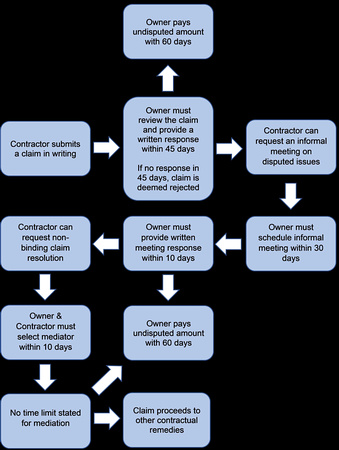New California Public Works Claims Resolution Process by Ken Fredrickson
Effective January 1, 2017, California Public Contract Code Section 9204 was added. This new regulation establishes a claims resolution process for state and local public contracts. The intent of the regulation is to ensure that contractors are paid for undisputed claims in a timely manner, that interest is due for amounts not paid in a timely manner, and that there is a process for resolving disputed issues. Except for those entities specifically excluded, the new regulation applies to all California public entities – state agencies, local cities and counties (including charter cities and counties), districts, special districts, public authorities and others.
The regulation puts into place a multi-step process for the handling of construction claims with specified notification and response times:
- A contractor submits a claim, in writing, by registered or certified mail.


- An owner has no more than 45 days to review and provide the contractor with a written response stating what parts of the claim are disputed or undisputed. The time can be extended by mutual agreement and, if the owner must get approval from a governing board that does not meet within the allowed time period, the response must be provided within three days of the meeting of the governing board.
- Payment of undisputed amounts must be made within 60 days after issue of the written response
- Failure of the owner to respond within the time allowed shall result in the claim being rejected in its entirety
- If the contractor disagrees with the response, or of the owner fails to respond, the contractor may request in writing (registered or certified mail) an informal conference to meet and confer on the issues in dispute. The owner has 30 days to schedule such a conference (it is unclear whether the conference must be scheduled or held within 30 days)
- Payment of undisputed amounts must be made within 60 days after issue of the written response
- Within 10 days following the conference, the owner must provide a written statement of any items that remain in dispute.
- The contractor may notify the owner in writing (no time restriction is stated) of any outstanding disputed items.
- Any disputed issues that remain shall be submitted to non-binding dispute resolution, the costs of which will be split equally. Agreement on the mediator must be done within 10 days after the remaining disputed issues have been identified in writing ( no time restriction is stated for submitting the dispute to the mediation process or for action by the mediator).
The last step in the process is to take the disputed claim to mediation or some other non-binding dispute resolution process. The agency and contractor may agree to waive this step and proceed directly to arbitration or litigation, however, the intent of the regulation is to create an avenue for timely, fair and practical resolution of construction claims. There are a variety of options available for non-binding dispute resolution but it makes sense to anticipate which approach is best for each project and agency and to include language in the contract appropriate to the option desired so that the process moves forward smoothly within the relatively short window provided. If mediation is the desired approach, the contract should state where and how a mediator will be selected. If it is intended to use a Project Neutral, the process for selection of this individual and the schedule for selecting this person should be stated. If a Dispute Resolution Board (permanent or ad hoc) is the selected process, the process for member selection, selection schedule and the responsibilities of the Board need to be described. Each of these approaches have advantages and disadvantages as well as varying costs.
The regulation does allow public agencies to be reimbursed for higher administrative costs associated with the new process so it is important that each agency have a system on place that allows for the collection of costs and time spent associated with administration of the new process.
The new law applies to all public works projects contracted after January 1, 2017 and is scheduled to sunset on January 1, 2020.